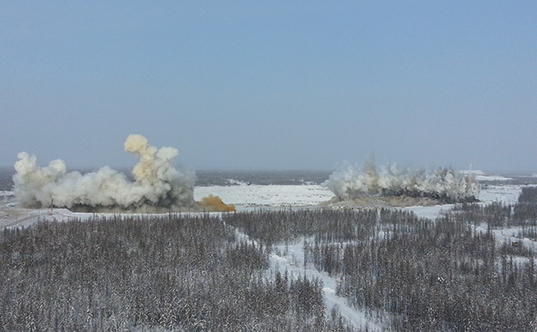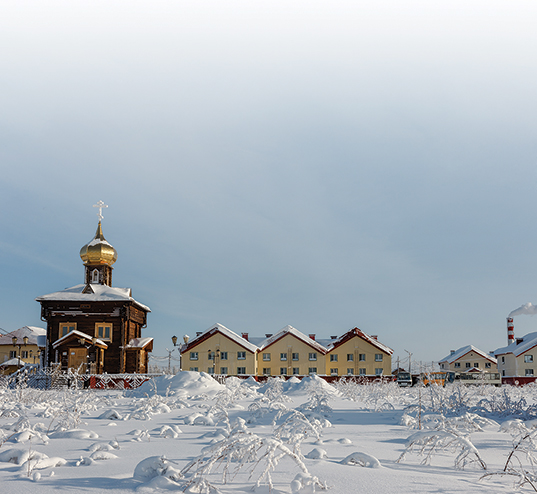|
Industry
Botuobinskaya Comes Online
ALROSA launches its first new pipeline in ten years.
By Svetlana Shelest

| | Rock blasting works at Botuobinskaya. Photo by Svetlana Shelest. |
Russia’s largest diamond miner ALROSA officially launched the Botuobinskaya kimberlite pipe into production on March 10, 2015, the first new pipe launch in Yakutia in ten years. In 2015, Botuobinskaya is expected to produce 230,000 tons of ore and about 1 million carats of rough. The long-term production plan for the pipe sets the annual target at more than 2 million carats when the deposit reaches its design capacity of 400,000 tons of ore per year. The identified reserves of Botuobinskaya were assessed at 13.679 million tons of ore containing 71.044 million carats of rough diamonds, with an average 5.65 diamond carats per ton under Joint Ore Reserves Committee (JORC) standards. The reserves contain a fairly large proportion of gem-quality and near-gem-quality crystals, with a high degree of transparency. This makes Botuobinskaya one of the richest pipes on ALROSA’s roster, outflanked only by the miner’s prized International pipe, which boasts an average diamond grade of over 8 carats per ton. The open pit production is operated by the company’s Nyurba Mining and Processing Division (MPD), which was established in 2000 to develop the Nakyn ore field in Yakutia’s Nyurba province. The Nakyn ore field comprises the Nyurbinskaya pipe, which has been ALROSA’s main production site in Nyurba over the past 15 years, and the Botuobinskaya and Mayskaya pipes, as well as the Nyurbinskaya and Botuobinskaya diamond placers. In 2014, the Nyurba MPD, which accounted for 20 percent of ALROSA’s overall production with just one pipe in operation, was outperformed only by the company’s Aikhal division, which operates three pipes that produced 35 percent of the company’s 2014 output. The first rock blast at Botuobinskaya occured on December 24, 2012, and regular stripping operations were performed throughout 2013 until December 31, 2014. Over these two years, almost $50 million was spent removing 406 million cubic feet of waste rock to build a pit measuring almost 300 feet deep and approximately 3,000 feet across. The long-term plan for Botuobinskaya is to continue open pit production until a depth of 1,900 feet is reached, tentatively set for 2039.
Botuobinskaya was the first of the Nakyn ore field pipes to be discovered, on March 29, 1994, but it had to wait its turn for development. Igor Uvarov, director of the Nyurba MPD, explains that a strategic switch was made in scheduling development after the Nyurbinskaya pipe was discovered in 1996. “Once all the feasibility studies were completed and analyzed, the decision was made to develop Nyurbinskaya first.” This was in view, he continues, “of the pre-assessed higher volume of its reserves and more massive ore body.” As a result, Nyurbinskaya was launched into production in 2000. The launch of Botuobinskaya 15 years later is part of ALROSA’s strategic plan to increase the company’s overall diamond production to 41.3 million carats by 2021. The pipe’s short-term role in this plan is to maintain the production capacities of the Nyurba MPD during the time the Nyurbinskaya pipe is on hold for reconstruction. The depth of the Nyurbinskaya pit already has reached almost 1,000 feet, and to continue production, additional development is required in order to extend the pipe until it reaches its design depth of approximately 1,900 feet. “Once the reconstruction is complete, the company will continue to operate both pipes. However, the total production will be capped by the capacities of the existing Nyurba processing facilities of around 7.5 million carats per year,” comments Igor Sobolev, ALROSA’s first vice president and executive director. “Indeed, the reserves of Botuobinskaya are characterized by a better average diamond quality and greater quantity compared to Nyurbinskaya, yet we do not plan to step up its production. We certainly could have opted to do just that, but this would undermine our future prospects. The more we mine now, the faster we’ll exhaust the reserves. Also, increased production would require us to enhance processing capacities, which means additional investment, and we do not plan on doing that.” Since the beginning of 2015, production at Botuobinskaya has been preparing a test batch of rough that will be assessed for grade and quality by ALROSA’s Rough Sorting Center and then by Gokhran, Russia’s State Precious Metals and Gems Repository, in terms of its marketability and value. Based on those findings, the marketing strategy and sales channels for the Botuobinskaya rough will be defined later this spring. “I haven’t seen the rough from Botuobinskaya myself yet,” says Uvarov, “but I’m sure the entire world is very interested to see it.”
The ore from Botuobinskaya is being processed at the Nyurba MPD’s year-round processing plant #16, which has been in operation since 2003. The plant was designed and built to incorporate all the best practices and technologies at the time, and still remains one of the most advanced in the global diamond industry. ALROSA’s St. Petersburg–based research and development branch, Bourevestnik, well-known to diamond miners across the world for its trademark equipment, supplied the plant with its X-ray luminescence separation units. Currently, Bourevestnik’s newer development, X-ray transmission sorters, is being tested at the plant. The new technology will solve the problem of identifying nonluminescent diamonds in the ore, which will in turn increase production levels. With a high level of automation, the plant, operated by a total of 220 staff working in shifts of 70 to 90 people, processes 1.5 million tons of ore annually. Nyurba MPD’s processing capacities also include processing plant #15, where seasonal operation from May to October processes sand and gravel only. Operating since 1999, plant #15 has been processing on average 500,000 tons per season. A rotation camp has been built here, in the middle of a thick coniferous snow forest approximately 100 miles from the nearest city of Nyurba and almost twice that far from ALROSA’a headquarters in Mirny. The camp accommodates 600 people working at both plants and maintenance and administrative staff. As part of ALROSA’s effort to preserve the unique nature of the Nakyn region and in line with its pledge of environmental conservation, Nyurba MPD has recently upgraded the tailings facilities shop of the main plant with seven Diemme filter press units that will allow the introduction of dry stacking into the process and discontinue the use of the tailing pond. Overall, ALROSA’s current long-term strategic plan for the Nakyn ore field pipes, including Botuobinskaya, extends to 2042. Development of the field’s third pipe Mayskaya, which was discovered in 2006 and officially placed on ALROSA’s balance sheet in 2014, is scheduled to begin in 2019, just as production at Nyurbinskaya is expected to decline and Botuobinaskaya is reaching full capacity. “The development strategy for our Yakutia operations is to maintain stable output volumes there, while Severalmaz in the Arkhangelsk region will be our growth engine. We also consider it important to ensure continuous operation of our processing facilities at their full capacity at all times, including the times the mines will have to go on hold for regular maintenance or capital works,” explains Sobolev, noting that “Botuobinskaya and Nyurbinskaya will be our back-up capacity for all such cases.”

| | Rotation camp for Nyurba Mining and Processing Division. Photo courtesy ALROSA. |
Article from the Rapaport Magazine - April 2015. To subscribe click here.
|
|